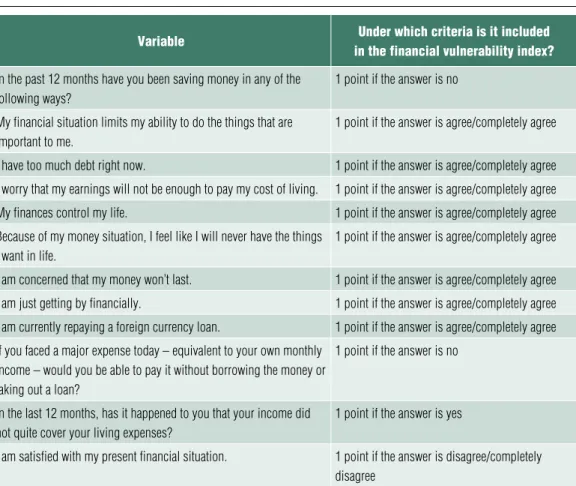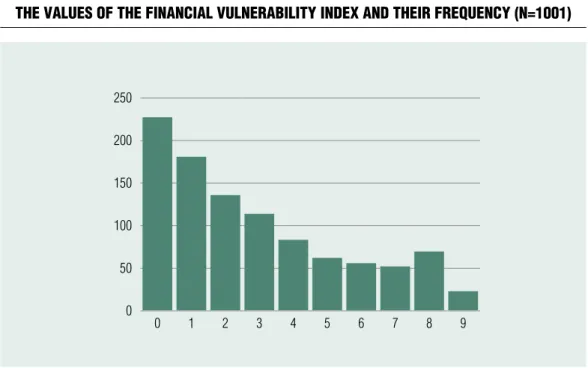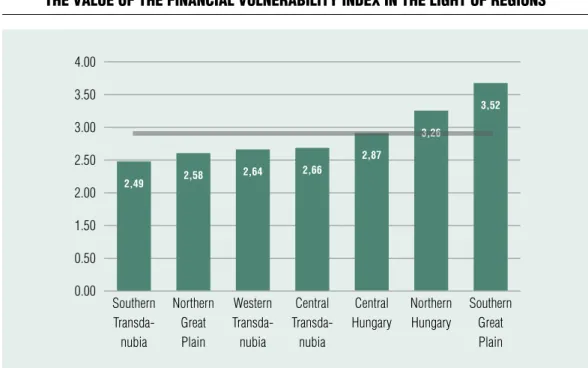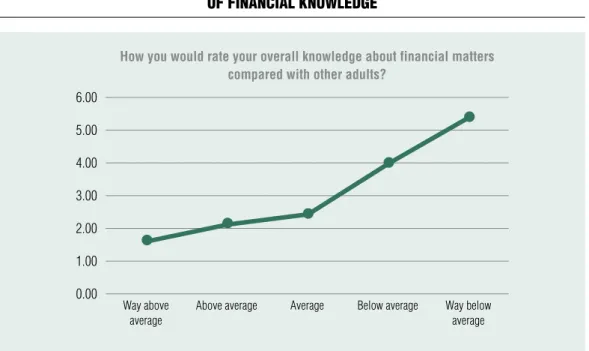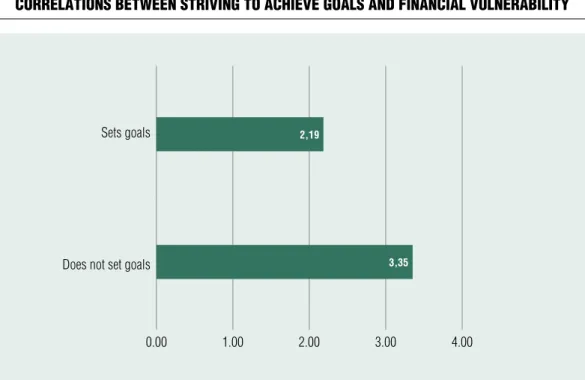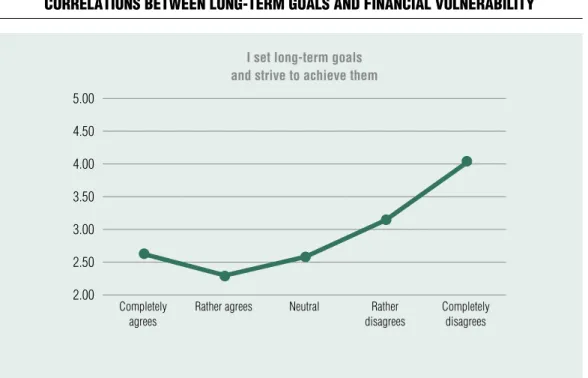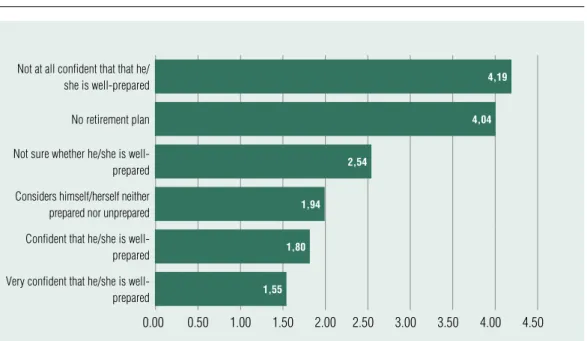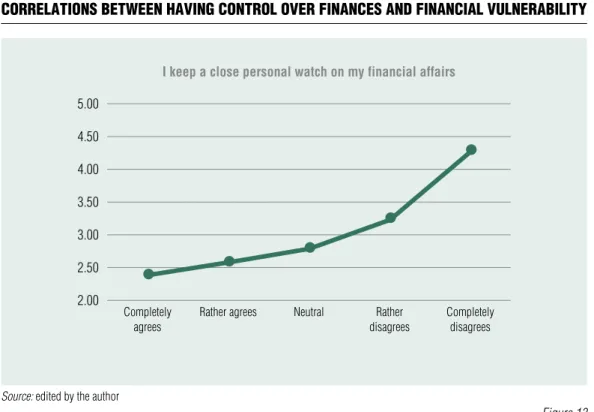N
Erzsébet Németh – Boglárka Zsótér – Dániel Béres
Financial Vulnerability
of the Hungarian Population
Empirical Results Based on 2018 Representative Data
Summary: The aim of this paper is to introduce a new method to measure Financial Vulnerability Index (FVI) based on OECD financial literacy survey, and to analyse the 2018 OECD survey data along FVI. The sample used in the article is representative for Hungary (sample size: 1,001). Our analysis sharply points out that although the growth of income reduces financial vulnerability, the higher disposable amount does not increase financial awareness. One of the key findings of the research is the identification of the correlations between financial attitudes and financial vulnerability. Our analysis shows that the difficulty of prolonging current desires is a significant factor underlying the development of financial vulnerability. Financially vulnerable population groups not only often struggle to make ends meet, but they also have difficulty controlling spending money.1 KeywordS: financial vulnerability, financial literacy, financial attitudes
JeL-codeS: A13, D03, D12, I22
doI: https://doi.org/10.35551/PFQ_2020_2_8
Nowadays, the improvement of the population’s financial literacy is identified as a national strategic priority in about 60 countries, and it became particularly common in the period following the onset of the financial crisis (Jakovác and Németh, 2017).
The Hungarian population was greatly and severely affected by the crisis; as a result, the initiatives focusing on financial awareness were launched in Hungary, too, as a natural response. The aim of the programme named
‘OKOSAN a Pénzzel! – Pénzügyi tudatosság fejlesztése Magyarországon’ (SMART Money Management – The Improvement of Financial Awareness in Hungary), created in 2017, is to strengthen financial literacy and develop associated programmes in order to ensure that similar critical events can be avoided or prevented, and if they still occur, the consumers can react to them better than before. it is the prerequisite of successful practical work that the future action plans must be based on research prepared with scientific rigour. The OeCd’s research on financial literacy was carried out in 2018 in Hungary on a sample consisting of 1,001 persons. The resulting E-mail address: enemeth@metropolitan.hu
boglarka.zsoter@uni-corvinus.hu dberes@metropolitan.hu
database provides the basis for the analyses and results presented in this research. The aim of the study is to present the newly established indicator – the financial vulnerability index – and the demographic, attitudinal and behavioural characteristics thereof.
The OeCd questionnaire assessing financial literacy touches upon numerous areas of the latter: financial behaviour and habits – including savings patterns, product knowledge and use – financial attitude, and financial knowledge.
LITErATurE rEVIEw
The phenomenon of financial vulnerability is of growing interest in the international literature, especially due to its impact on the economy (Poh-Sabri, 2017). The financial crisis and its consequences have made financial vulnerability an increasingly important topic in the financial literacy research (Németh et al., 2017; Poh-Sabri, 2017). The crisis reached Hungary in a particularly vulnerable state (Kolozsi, Hoffman, 2016). The so-called foreign currency loan crisis accompanying the 2008 financial crisis made masses of people financially vulnerable (Zsótér et al., 2017).
According to the definition of Anderloni et al. (2012) financial vulnerability goes together with high indebtedness and other financial problems, as a result of which the households cannot cover their everyday expenses, and cannot take care of their future retirement years. in their definition financial vulnerability goes hand in hand with a low standard of living and poor heath, as well as households not being able to cope with unexpected financial difficulties. The research in developing countries associates financial vulnerability mainly with low income. Their reasoning is based on the vulnerability caused by poor health, difficult living conditions, and
poor social and economic conditions resulting from low income (Lewis and AV Lewis, 2014;
Guarcello et al., 2010).
Financial vulnerability influences financial wellbeing at both individual and household level. Poh and Sabri (2017) established that high vulnerability is coupled with low income, low liquidity and, often, financial problems, while unemployment is also a typical feature of financially vulnerable individuals. According to the findings of Finney and Jentzsch (2008) financially vulnerable households faced financial problems more frequently in the period under examination, and typically felt that their situation was insoluble. When examining financial vulnerability, Schofield et al. (2010) also emphasise the intensity of financial stress and the lack of ability to cope with it. The research of Al-Mamun and Mazumder (2015) concluded that financial vulnerability and poverty are closely related phenomena. Some studies also highlight that there is a discrepancy between urban and rural households as well in terms of financial vulnerability, as the latter ones are more vulnerable (Yusof et al., 2015).
in their research conducted in Malaysia, Daud et al. (2018) established an order of priority consisting of variables resulting in financial vulnerability: income, marital status, age, educational attainment and money management skills.
The majority of the studies examine the level of income, the financial difficulties and problems, as well as the ability/inability to cope with financial difficulties in terms of their relationship with financial vulnerability.
Bárczi and Zéman (2015) highlight that the concept of financial literacy is often narrowed down to the financial knowledge belonging to the visible part of literacy, ‘above the surface’.
The majority of the studies conducted in the area of financial vulnerability highlight the demographic variables in addition to the
above. At the same time, the incorporation of the behavioural and attitudinal components of financial knowledge and financial literacy into such research is less pronounced.
When examining the financial literacy of the population, attention should be paid to financial knowledge, financial behaviour and financial attitudes as well (Atkinson, Messy, 2012). Similarly, to financial vulnerability, financial behaviour is also an important factor that influences financial wellbeing (Garman, Forgue, 2006). When it comes to the financial behaviour of consumers, we focus on the control and implementation of personal finances at individual level (Martur 1989), and we look at the details such as financial foresight, planning of expenditure, keeping records of loans and cash, major investments, purchasing insurance, investments and retirement planning. The study of Xiao (2010) classifies every human behaviour which may be relevant in the context of personal finances under the name of financial behaviour. His definition includes the management of cash, savings and loans. Attention must be paid to attitudes in addition to behaviour. The relationship with money and finances has been an area of research since the 1970’s (Goldberg and Lewis, 1978). Several studies conducted in the area of financial education highlight that it is insufficient to merely expand financial knowledge and financial competences, but shifting towards a positive financial behaviour should be set as an objective (Hilgert et al., 2003; Xiao et al., 2004). to achieve this, it is not enough to merely transfer information, but it is also necessary to develop further important skills and competences, and in many cases the attitude also needs to be changed (Hilgert et al., 2003; drever et al., 2015). The concept of financial attitude and that of attitude towards money are not necessarily distinct from each other, or they overlap in many
studies (Goldberg, Lewis, 1978; Yamauchi, templer, 1982; Furnham, 1984; tang, 1992;
Nagy, tóth, 2012).
A previous study grouped young people between 18 and 35 years of age according to financial behaviour and attitudes by using a cluster analysis (Németh et al., 2017). The results of the analyses highlighted a very vulnerable group: anxious spenders. The cluster is distinguished by the fact that they have the most financial problems compared to the others, while they have little or no savings at all. At an emotional level they are typically worried and anxious when it comes to finances. despite that, they appeared in the analysis as the group of the biggest spenders.
Their financial knowledge is usually low and they do not keep track of their expenditures.
They are not self-confident about their financial knowledge and future. The ‘feast or famine’ approach is the best way to describe them (Németh et al., 2016). All these features make them vulnerable in respect of their finances (Németh et al., 2017; Németh, Zsótér, 2019). Luksander et al. (2017) identified the personality traits and behavioural patterns affecting the indebtedness of the individuals based on the results of a financial personality test. Their results suggest that the most threatening factor from the perspective of the avoidance of indebtedness is reliance on luck.
Gambling refers to being driven by external control.
The aim of the research presented below is to take stock of the most significant correlations of financial vulnerability mentioned in the academic literature. The research seeks answer to the question as to how certain socio-demographic indicators (age, gender, educational attainment, income, place of residence, employment), certain attitudes and behaviours, as well as characteristics in terms of knowledge relate to financial vulnerability. to find these connections, the
researchers developed a new, complex financial vulnerability index.
METHODOLOgy
As a result of the research carried out on the OeCd databases for 2010 and 2015, and other research relating to financial literacy, a very important phenomenon emerged, namely financial vulnerability (Németh et al., 2017).
The examination of the 18-35 age group in the OeCd database for 2015 proved that there is a group of anxious spenders, which accounts for one quarter of young people.
typically, they live for today, while they are often anxious, they have no savings, they have lower incomes, and they do not typically set financial goals. On the basis of all this, this is a financially vulnerable group (Németh et al., 2017). Poh and Sabri (2017) suggest in their summary study on financial vulnerability that it is worth defining financial vulnerability as a multi-dimensional concept. By pursuing the previous two trains of thought further, we developed the Financial Vulnerability index (hereinafter referred to as FVi) which consists of a total of 12 variables from the 2018 OeCd survey questions. The variables show, among others, the subjective assessment of the financial situation, the degree of indebtedness and financial limitation, the lack of savings and the appearance of anxiety about finances.
The variables were included in the FVi with equal weights and the scores gained from them were added up. Table 1 illustrates which variable of the 2018 OeCd survey was taken into account and under what criteria.
The recommendation made by Poh and Sabri (2017) that the concept is multidimensional and thus approaches financial vulnerability in a complex manner is, therefore, fulfilled. Based on the calculation method, the lowest value of the FVi is 0, and
the highest is 12. After calculating the index, if there is any statistically significant connection exists between FVi and other variables from the 2018 OeCd financial literacy survey database. two- and multi-variable statistical analyses were executed. Besides, crosstab analyses was employed between the non- metric variables. The paper contains only the results that are statistically significant.
rEsuLTs
The FVi can take a value between 0 and 12.
On the basis of the OeCd’s 2018 database the average of the index is 2.88 (deviation=2.67), the lowest value taken is 0, and the highest value taken is 9. Figure 1 shows the frequency of the scores.
The figure shows clearly that 70 percent of the Hungarian population chose a little less than 3 possible answers which refer to financial vulnerability. Besides the above, most of them – about every fourth respondent – did not give an answer suggesting financial vulnerability to any of the questions; the highest index (9) was also quite rare, and we did not find any respondent with a value above that. The examination of the values taken by the FVi in itself would have been insufficient, but the identification of the correlations with socio- demographic, attitudinal and behavioural characteristics can provide a deeper insight into this aspect of financial literacy.
The FVi shows significant correlation with the following demographic variables:
• gender
• place of residence (region)
• educational attainment
• employment relationship
• income
the FVi is significantly higher in case of women (3.05) than men (2.68). This may be due to the lower income level measured
in case of women, or their higher level of dissatisfaction and anxiety even in case of equal income. See figure 2.
the place of residence. in terms of place of residence we also found some significant differences. The FVi takes the highest value in the region of the South Great Plain (3.52), which is followed by Northern Hungary (3.26). The lowest value is observed in Southern transdanubia (2.49). See figure 3.
it is an interesting finding that although we found significant differences between each Hungarian region in terms of financial
vulnerability, we could not reveal an unambiguous correlation between the development level of the regions, the income level of those living there and the degree of financial vulnerability. All this suggests that there may be multiple reasons for financial vulnerability, which we shall address later.
educational attainment. The FVi shows a significant correlation with educational attainment. The least financially vulnerable people are those with a higher educational attainment (1.69) and the most vulnerable are those with lower than primary educational
Table 1 The variables included in The financial vulnerabiliTy index
and Their criTeria
variable under which criteria is it included
in the financial vulnerability index?
In the past 12 months have you been saving money in any of the following ways?
1 point if the answer is no My financial situation limits my ability to do the things that are
important to me.
1 point if the answer is agree/completely agree I have too much debt right now. 1 point if the answer is agree/completely agree I worry that my earnings will not be enough to pay my cost of living. 1 point if the answer is agree/completely agree My finances control my life. 1 point if the answer is agree/completely agree Because of my money situation, I feel like I will never have the things
I want in life.
1 point if the answer is agree/completely agree I am concerned that my money won’t last. 1 point if the answer is agree/completely agree I am just getting by financially. 1 point if the answer is agree/completely agree I am currently repaying a foreign currency loan. 1 point if the answer is agree/completely agree If you faced a major expense today – equivalent to your own monthly
income – would you be able to pay it without borrowing the money or taking out a loan?
1 point if the answer is no
In the last 12 months, has it happened to you that your income did not quite cover your living expenses?
1 point if the answer is yes
I am satisfied with my present financial situation. 1 point if the answer is disagree/completely disagree
Source: edited by the author
Figure 2 The value of The financial vulnerabiliTy index in The lighT of genders
3.50 3.00 2.50 2.00 1.50
1.00 women Men
Source: edited by the author
3,05
2,68 2,88
Figure 1 The values of The financial vulnerabiliTy index and Their frequency (n=1001)
250 200 150 100 50
0 0 1 2 3 4 5 6 7 8 9
Source: edited by the author
attainment (5.00), while a secondary educational attainment without secondary school leaving certificate still goes together with a higher than average vulnerability.
Figure 4 clearly indicates that the absence or inadequacy of qualification constitutes a serious risk factor from the point of view of financial vulnerability. The lack of the skill of reading for understanding and basic calculation competences can make those concerned dependent and vulnerable.
employment relationship. With regard to employment relationship it can be reasonably said that those the most vulnerable are job seekers/the unemployed (5.15), and they are followed by individuals incapacitated for work due to illness or health impairment (4.83).
The least vulnerable group are that of the self- employed (1.51). See figure 5.
it is not surprising that unemployment and illness represent serious risk factors from
the perspective of financial vulnerability.
At the same time, it is remarkable that the financial vulnerability level of pensioners and the employed is the same, while their income level differs significantly. The other important finding is the particularly low level of vulnerability of the self-employed/
entrepreneurs. All this suggests that the economic recovery brought about new opportunities for them, of which they made good use. These factors also highlight the significance of attitudes and behaviour.
in terms of income, it can be reasonably said that the less income an individual has, the more financially vulnerable they become. Figures 6 and 7 clearly show that the level of income correlates with financial vulnerability, which is not surprising at all;
however, as we will see later, it is one of the several factors.
The question as to how long the respondent Figure 3 The value of The financial vulnerabiliTy index in The lighT of regions
4.00 3.50 3.00 2.50 2.00 1.50 0.50
0.00 southern Transda
nubia
Northern great Plain
western Transda
nubia
Central Transda
nubia
Central Hungary
Northern Hungary
southern great Plain
Source: edited by the author
2,49 2,58 2,64 2,66
2,87
3,26
3,52
Figure 4 The value of The financial vulnerabiliTy index in The lighT of educaTional
aTTainmenT
6.00 5.00 4.00 3.00 2.00 1.00
0.00 Tertiary ed
ucational at
tainment
second
ary educa
tional attain
ment…
second
ary educa
tional attain
ment…
second
ary educa
tional attain
ment…
Primary ed
ucational at
tainment
Lower than primary ed
ucational at
tainment Source: edited by the author
1,69
2,40 2,42
3,37 3,77
5,00
Figure 5 The value of The financial vulnerabiliTy index in The lighT of employmenT
relaTionship
6.00 5.00 4.00 3.00 2.00 1.00 0.00
selfemployed Fulltime student Intern Employed Pensioner Nonjob seeker (inactive) Other stayathome parent Illness or health impair ment… Job seeker / unemployed
Source: edited by the author 1,51
1,94 2,00
2,87 2,89 3,00
4,23 4,47 4,83 5,15
Figure 6 The value of The financial vulnerabiliTy index in The lighT of income!
4.00 3.50 3.00 2.50 2.00 1.50 0.50
0.00 Below huf 180
thousand per month Between huf 180 and 300 thousand per
month
Above huf 300 thousand per month
Source: edited by the author
3,78
3,02
1,96
Figure 7 correlaTions beTween The consequences of loss of income and financial
vulnerabiliTy
If you lost your main source of income, how long could you continue to cover your living expenses without borrowing or taking out a loan?
6.00 5.00 4.00 3.00 2.00 1.00
0.00 Less than a week
At least a week, but not one
month
At least one month, but not
three months
At least 3 months, but not
six months
More than six months
Source: edited by the author
could continue to cover their living expenses without borrowing or taking out a loan in case of losing the main source of income also shows a significant correlation with financial vulnerability. Those who would be able to maintain their household for less than a week in such a situation have a FVi of 5.46. And those who responded that they would be able to cover their living expenses for six months or even longer have a FVi of 1.04.
Own financial knowledge. The respondents were also asked how they rated their financial knowledge compared with other adults. This variable shows a significant correlation with financial vulnerability.
Those who are confident in their knowledge, that is, consider their own knowledge above- average, have an average FVi of 1.74, while in case of those who represent the other extreme, that is, consider their financial
knowledge way below the average, this value is 5.49. The latter one is quite a high value, which also shows that besides the lack of financial knowledge it is also important how confident the respondent is about their own knowledge. See figure 8.
the basic financial calculations sub- index. The correlation between the basic financial calculations sub-index (Financial Knowledge) and the FVi shows that the poorer an individual performs when solving the tasks measuring knowledge, the higher this person’s FVi will be. The rate of the Pearson correlation is -0.117, which shows a poor negative relation.
On the whole, therefore, both the subjective (how the respondent rates their own financial knowledge) and the objective (knowledge test) financial knowledge shows correlation with vulnerability.
Figure 8 The relaTionship of The financial vulnerabiliTy index and The raTing
of financial knowledge
How you would rate your overall knowledge about financial matters compared with other adults?
6.00 5.00 4.00 3.00 2.00 1.00
0.00 way above average
Above average Average Below average way below average
Source: edited by the author
the financial goals. Financial vulnerability shows a significant correlation with financial goals, as those who do not usually set financial goals have a significantly higher score in terms of vulnerability. See figure 9.
Those who saved their money in order to achieve the financial goals set by them reached a significantly lower score in terms of financial vulnerability.
Another variable also relates to objectives:
this is an attitude statement which says: ‘I set long-term goals and strive to achieve them’.
it is in line with the previous finding that in case of this statement agreement implies a lower financial vulnerability score, while disagreement goes together with a higher vulnerability score. See figure 10 and table 2.
the level of preparedness for retirement years. A statistically significant correlation exists between the level of preparedness for
retirement years and financial vulnerability, which is as follows: those who are well- prepared have a low FVi (1.55), and the lower the feeling of preparedness, the higher the score of vulnerability, while in case of those who are not at all sure whether they have prepared well for their retirement years this value is 4.19. See figure 11.
There were several possible answers to the question as to from what the respondent will get pension:
• state pension,
• pension paid by the employer,
• private pension,
• from selling financial instruments, invest- ments,
• from selling movable property and real estates,
• from investment revenue,
• from support received from his/her partner,
Figure 9 correlaTions beTween sTriving To achieve goals and financial vulnerabiliTy
sets goals
Does not set goals
0.00 1.00 2.00 3.00 4.00
Source: edited by the author
2,19
3,35
• from support received from children and other family members,
• from savings made earlier,
• continuing work,
• from the revenues of own his/her business,
• other.
We found significant correlation with the FVi in case of three of the answers provided:
previous savings, private pension, continuing work. in case of these three items, it can
be said that those who chose them have a significantly lower FVi than those who did not. Self-support goes together with a lower vulnerability.
Financial behaviour. An aspect of financial behaviour relating to everyday finances – monitoring, keeping a close watch on, taking stock of and controlling finances – also shows a significant correlation with financial vulnerability. Based on the relevant Figure 10 correlaTions beTween long-Term goals and financial vulnerabiliTy
I set long-term goals and strive to achieve them 5.00
4.50 4.00 3.50 3.00 2.50
2.00 Completely agrees
rather agrees Neutral rather
disagrees
Completely disagrees
Source: edited by the author
Table 2 correlaTions beTween savings formed To achieve goals
and vulnerabiliTy
financial vulnerability index
He/she saved money to achieve goals. 1.61
He/she did not save money to achieve goals. 2.71
Source: edited by the author
attitude statement, it can be said that the more an individual tends to have control over their finances, the less vulnerable they are and vice versa.
it is an important question as to what extent those in a financially more dependent situation are able and willing to have control over their finances, keep a close watch on them and budget their money. See figure 12.
Caution and prudence before making purchases is typical of those who have a high financial vulnerability score. This may be in correlation with the low income. See figure 13.
The fact that those who spend their salary before the end of the month can be characterised by a higher financial vulnerability score can also be in correlation with low income. See figure 14.
The results point out sharply that financial behavioural factors also play a significant role in the background of financial vulnerability.
The statement relating to the payment of bills shows an interesting correlation with financial vulnerability in comparison with the above. Those who have low financial vulnerability either think that the statement that they pay their bills on time applies to them fully or does not apply at all. Thus, they are located at two opposite extremes. The most vulnerable (4.67 points) consider the statement that they pay their bills on time as less true of themselves, which can be in correlation with low income and the lack of savings. See figure 15.
in case of the purchase of products and services, the product description or the contract contains small prints, and the OeCd’s 2018 survey also included a statement about reading them. Those who do not read such parts unless something goes wrong can be characterised by a higher score in terms of financial vulnerability. See figure 16.
Figure 11 correlaTions beTween preparedness for reTiremenT years and financial
vulnerabiliTy
Not at all confident that that he/
she is wellprepared No retirement plan Not sure whether he/she is well
prepared Considers himself/herself neither
prepared nor unprepared Confident that he/she is well
prepared Very confident that he/she is well
prepared
0.00 0.50 1.00 1.50 2.00 2.50 3.00 3.50 4.00 4.50
Source: edited by the author
4,19 4,04
2,54 1,94
1,80 1,55
Figure 12 correlaTions beTween having conTrol over finances and financial vulnerabiliTy
I keep a close personal watch on my financial affairs 5.00
4.50 4.00 3.50 3.00 2.50
2.00 Completely agrees
rather agrees Neutral rather
disagrees
Completely disagrees
Source: edited by the author
Figure 13 correlaTions beTween cauTion before making purchases and financial
vulnerabiliTy
Before I buy something. I carefully consider whether I can afford it
4.50 4.00 3.50 3.00 2.50 2.00 1.50 1.00 0.50
0.00 Completely true
rather true Neutral rather not true Not true at all
Source: edited by the author
Figure 14 correlaTion beTween spending The salary and financial vulnerabiliTy
I have money left over at the end of the month 6.00
5.00 4.00 3.00 2.00 1.00
0.00 Completely true
rather true Neutral rather not true Not true at all
Source: edited by the author
Figure 15 correlaTions beTween The paymenT of bills and financial vulnerabiliTy
I pay my bills on time
5.00 4.50 4.00 3.50 3.00 2.50
2.00 Completely true
rather true Neutral rather not true Not true at all
Source: edited by the author
Where people only rely on luck. there are, indeed, situations where people only rely on luck. OeCd’s 2018 survey includes an attitude statement relating to this: ‘I buy a lottery ticket when I feel like I don’t have enough money’ those who are characterised by this behaviour are more financially vulnerable than those who do not tend to leave their prosperity up to chance. Reliance on luck as a coping mechanism suggests an external control attitude. Numerous studies revealed that poverty and external control attitude are in a mutual causal relationship, since those who expect their change of fortune from other people or luck are less able to cope with difficulties. At the same time, those who are in a disadvantageous situation experience that they have no influence on their lives, which also increases the tendency to have an external control attitude. See figure 17.
Careful financial behaviour, financial awareness. We found a significant correlation between the careful financial behaviour, financial awareness (Financial Behaviour) sub- index and the FVi. The rate of the Pearson correlation is -0.203, which shows a poor negative relation between the two measures.
This means that the more conscious someone is in terms of their finances, the less vulnerable they are.
the OeCd database includes the following possibilities concerning the types of products owned by the respondent:
pension savings, investment account, mortgage, loans secured by real-estate property, unsecured bank loans, auto loan, credit card, current account, savings account, microloan, insurance, stock, bond, mobile payment, debit card. it can be said about the respondents who have the following products among those listed above that they
Figure 16 correlaTions beTween reading The small prinT and financial vulnerabiliTy
I tend to ignore the small print unless something goes wrong
4.50 4.00 3.50 3.00 2.50 2.00
Absolutely typical
rather typical Neutral rather not typical
Not typical at all
Source: edited by the author
are significantly less vulnerable than those who do not have these products:
• pension savings,
• current account,
• savings account,
• insurance.
the degree of using these financial instruments. There is a negative relationship between the degree of using these financial instruments, that is, the Financial Inclusion Index, and the FVi (Pearson correlation:
-0.59). This relationship is statistically significant at a significance level of 10 percent.
The correlation indicator can be interpreted as meaning that the more financial products an individual knows and uses, the less vulnerable they are.
Financial attitude. The value of the Pearson correlation between the financial attitude sub- index and the FVi is -0.37. That means that there is a moderate negative relationship
between the two indexes. The comparison of the correlations between the FVi and the sub- indexes shows that the strongest correlation emerges in connection with attitudes.
There are 12+5+12 attitude statements in the OeCd’s 2018 database. We analysed a couple of these in the chapter discussing financial behaviour and financial vulnerability.
in the next part, we will present the attitude statements which were not mentioned in the chapter on behaviour and which correlate with financial vulnerability.
in case of those who find it more satisfying to spend money than to save it, we should expect a significantly higher vulnerability. See figure 18.
‘Money is there to be spent’ is a similar statement, and the results were also similar.
See figure 19.
The carpe diem attitude is formulated specifically in the third group of attitude Figure 17 relaTionship beTween reliance on luck and financial vulnerabiliTy
I buy a lottery ticket when I feel like I don’t have enough money
5.50 5.00 4.50 4.00 3.50 3.00 2.50 2.00
Absolutely typical
rather typical Neutral rather not typical
Not typical at all
Source: edited by the author
Figure 18 correlaTions beTween financial vulnerabiliTy and The feeling of carpe diem 1
I find it more satisfying to spend money than to save it for the long term
4.50 4.00 3.50 3.00 2.50
2.00 Completely agrees
rather agrees Neutral rather
disagrees
Completely disagrees
Source: edited by the author
Figure 19 correlaTions beTween financial vulnerabiliTy and The feeling of carpe diem 2
Money is there to be spent 4.00
3.80 3.60 3.40 3.20 3.00 2.80 2.60 2.40 2.20
2.00 Completely agrees
rather agrees Neutral rather
disagrees
Completely disagrees
Source: edited by the author
statements. This statement is directly proportional to financial vulnerability. See figure 20.
One of the key results of our research is the identification of the fact that financial vulnerability significantly correlates with the indicators mentioned. This means that the difficulty to have control over and postpone desires might be the reasons behind financial vulnerability. The presented figures show that the lack of foresight and the immediate spending of the money available at any given time are important factors in the background of extreme vulnerability.
in case of those who are risk averse, the score of financial vulnerability is lower, except for those who completely disagree with the relevant attitude statement. See figure 21.
The significant relationship between financial situation and vulnerability can be
characterised as follows: satisfaction is in an inverse relationship with vulnerability, the perception of financial situation as an obstacle and the level of indebtedness is in a positive relationship with vulnerability. Although all this is not surprising, it demonstrates that the FVi is a combination of factors correlating with each other; therefore, it clearly shows the factors intended to examine. See figure 22, 23, 24.‘I am just getting by financially’ is included in the third group of statements. This variable, similarly to the previous one, shows a statistically significant correlation with the FVi. The more typical it is of an individual to just get by financially, the more vulnerable they are. See figure 25.
The level of concern about financial matters and making ends meet shows a positive relationship with vulnerability. The more
Figure 20 correlaTions beTween financial vulnerabiliTy and The feeling of carpe diem 3
I tend to live for today and let tomorrow take care of itself 6.00
5.00 4.00 3.00 2.00 1.00
0.00 Absolutely typical
rather typical Neutral rather not typical
Not typical at all
Source: edited by the author
Figure 21 correlaTions beTween risk-Taking and financial vulnerabiliTy
I am prepared to risk some of my own money when saving or making an investment
4.50 4.00 3.50 3.00 2.50
2.00 Completely agrees
rather agrees Neutral rather
disagrees
Completely disagrees
Source: edited by the author
Figure 22 correlaTions beTween saTisfacTion wiTh financial siTuaTion and financial
vulnerabiliTy
I am satisfied with my present financial situation 6.00
5.00 4.00 3.00 2.00 1.00
0.00 Completely agrees
rather agrees Neutral rather
disagrees
Completely disagrees
Source: edited by the author
Figure 23 correlaTions beTween percepTion of financial siTuaTion as a limiTaTion and
financial vulnerabiliTy
My financial situation limits my ability to do the things that are important to me
7.00 6.00 5.00 4.00 3.00 2.00 1.00
0.00 Completely agrees
rather agrees Neutral rather
disagrees
Completely disagrees
Source: edited by the author
Figure 24 correlaTions beTween The level of indebTedness and financial vulnerabiliTy
I have too much debt right now 7.00
6.50 6.00 5.50 5.00 4.50 4.00 3.50 3.00 2.50
2.00 Completely agrees
rather agrees Neutral rather
disagrees
Completely disagrees
Source: edited by the author
typical it is of someone to worry about their financial situation, the higher value the FVi takes. See figure 26.
Another aspect of anxiety appears in the third group of attitude statements. This shows a similar picture to the previous statement about worry. See figure 27.
in addition to the different negative emotions, control also appears among the statements. if someone feels that their life depends on their financial situation and not controlled by themselves, that increases financial vulnerability as well. See figure 28.
Similarly to the previous statement, the third group of statements also includes a variable which makes the money situation responsible, but in this case not for the whole life, but in terms of the goals. The figure is nearly fully identical to the previous one. See figure 29.
Table 3 summarises the variables showing significant correlation with financial
vulnerability. The summary does not contain the attitude statements.
suMMAry, CONCLusIONs
As suggested by Poh and Sabri (2017) in their summary study on financial vulnerability, it is worth defining financial vulnerability as a multi-dimensional concept. We proceeded accordingly when we created the FVi made of 12 statements. in an academic sense, we developed the measurement of financial vulnerability further also by including the behavioural and attitudinal characteristics of financial literacy in addition the variables used in the international literature (Yusof et al., 2015; Lewis and AV Lewis 2014; Guarcello et al., 2010).
Our analysis sharply points out that although the growth of income reduces financial vulnerability, the higher disposable amount does not increase financial awareness.
Figure 25 correlaTions beTween The available budgeT and financial vulnerabiliTy
I am just getting by financially 8.00
7.00 6.00 5.00 4.00 3.00 2.00 1.00
0.00 Absolutely typical
rather typical Neutral rather not typical
Not typical at all
Source: edited by the author
Figure 26 correlaTions beTween anxieTy and vulnerabiliTy 1
I worry that my earnings will not be enough to pay my cost of living
7.00 6.00 5.00 4.00 3.00 2.00 1.00
0.00 Completely true
rather true Neutral rather not true Not true at all
Source: edited by the author
Figure 27 correlaTions beTween anxieTy and vulnerabiliTy 2
I am concerned that my money won’t last 8.00
7.00 6.00 5.00 4.00 3.00 2.00 1.00
0.00 Absolutely typical
rather typical Neutral rather not typical
Not typical at all
Source: edited by the author
Figure 28 correlaTions beTween The feeling of subjecTion and vulnerabiliTy 1
My finances control my life 7.00
6.00 5.00 4.00 3.00 2.00 1.00
0.00 Completely true
rather true Neutral rather not true Not true at all
Source: edited by the author
Figure 29 correlaTions beTween The feeling of subjecTion and vulnerabiliTy 2
Because of my money situation. I feel like I will never have the things I want in life
8.00 7.00 6.00 5.00 4.00 3.00 2.00 1.00
0.00 Absolutely typical
rather typical Neutral rather not typical
Not typical at all
Source: edited by the author
Table 3 summary of variables showing significanT correlaTion wiTh financial
vulnerabiliTy variables showing significant
correlation with financial vulnerability
description of the correlation
gender Financial vulnerability is higher in case of women.
Place of residence Financial vulnerability is the highest in the southern great Plain region and the lowest in south Transdanubia.
Educational attainment Those with higher educational attainment are the least financially vulnerable, and those with lower than primary educational attainment are the most vulnerable.
Employment relationship Job seekers/the unemployed are the most vulnerable. The selfemployed are the least vulnerable.
Income The less income an individual has, the more financially vulnerable they become.
Ability of selfsupport in case of losing the main source of income
The shorter someone is able to cover their living expenses, the more vulnerable they become.
selfassessment of financial knowledge The more confident someone is about their financial knowledge, the less vulnerable they are.
Objective level of financial knowledge The lower an individual’s financial knowledge is, the more financially vulnerable they are.
setting financial goals Those who set financial goals are less vulnerable.
The level of preparedness for retirement years
Those who are better prepared for their retirement years are less vulnerable.
Having control over finances The more typical it is of the individual to have control over finances, the less vulnerable they are.
Making considered purchases Caution and prudence before making purchases is typical of those who have a high financial vulnerability score.
Budgeting income Those who spend their salary before the end of the month can be characterised by a higher financial vulnerability score.
Payment of bills within the deadline The most vulnerable consider the statement that they pay their bills on time as less true of themselves.
getting informed before making purchases
Those who do not read such parts unless something goes wrong can be characterised by a higher score in terms of financial vulnerability.
relying on chance Those who are characterised by this behaviour are more vulnerable financially than those who are not.
Financial awareness The more conscious someone is in their finances, the less vulnerable they are.
The degree of using financial instruments
The more financial products an individual knows and uses, the less vulnerable they are.
Source: edited by the author
educational attainment is of significance from the point of view of financial vulnerability.
The findings of the research show that the absence of primary educational attainment is a serious threatening factor, and it is not sufficient to have a vocational qualification to achieve lower-than-average vulnerability, but it is important to have a secondary school leaving certificate. it seems that the secondary school leaving certificate ensures the basic literacy techniques, calculation and readings skills which are necessary for an informed decision-making, which is also correct arithmetically. The identification of the reasons for the deterioration measured in the area of calculation skills requires further research.
One of the key findings of the research is the identification of the correlations between financial attitudes and financial vulnerability.
Our analysis shows that the difficulty of prolonging current desires is a significant factor underlying the development of financial vulnerability. Financially vulnerable groups not only often struggle to make ends meet, but they also have difficulty controlling spending money. Although worry and anxiety are present in their lives at the level of emotions, they tend to overspend. They have
lower educational attainment, less financial knowledge, and they typically do not have control over their finances and do not make budgets. This group is not self-confident either about their financial knowledge or their future.
The absence of financial goals and making related strategies also contributes to financial vulnerability. This ‘feast or famine’ approach and the characteristics described above overall cause financial vulnerability and dependence in their everyday lives.
The findings of the research confirm that the goals and tools specified in the ‘financial awareness’ strategy are substantiated. The strategy highlights that the making of basic consumer decisions also requires increasingly diversified and in-depth knowledge and competence; however, the financial education of the population is far from adequate. in addition, impulsive and ill-considered decisions made without prudence and comparison are more and more typical. The demographic trends also make financial awareness increasingly important; therefore, the increased life expectancy, the higher quality requirements towards health care and the expansion of opportunities, as well as the focus on prevention increase the importance of self-support.
Note
References
1 The research was funded by the Money Compass Foundation and the State Secretariat for Financial Affairs of the Ministry of Finance.
Al-Mamun, A., Mazumder, M. N. H. (2015).
impact of microcredit on income, poverty, and economic vulnerability in Peninsular Malaysia.
Development in Practice, 25 (3), pp. 333-346, https://doi.org/10.1080/09614524.2015.1019339
Anderloni, L., Bacchiocchi, e., Vandone, d. (2012). Household financial vulnerability: An empirical analysis. Research in Economics, 66(3), pp.
284-296,
https://doi.org/10.1016/j.rie.2012.03.001
Atkinson, A., Messy, F. A. (2012). Measuring Financial Literacy: Results of the OECD International Network on Financial Education (INFE) Pilot Study.
OeCd Working Papers on Finance, insurance and Private Pensions, No. 15, OeCd Publishing, Paris
Bárczi, J., Zéman, Z. (2015). A pénzügyi kultúra és annak anomáliái. (Financial Literacy and its Anomalies.) Polgári Szemle/Civic Review 11 (1-3) pp.
23-41
daud, S. N. M., Marzuki, A., Ahmad, N., Kefeli, Z. (2018). Financial Vulnerability and its determinants:
Survey evidence from Malaysian Households. Emerging Markets Finance and Trade, 55 (9),
https://doi.org/10.1080/1540496x.2018.1511421 Finney, A., Jentzsch, N. (2008). Consumer Financial Vulnerability: technical Report. European Credit Research, pp. 1-52
Furnham, Adrian F. (1984). Many Sides of the Coin: The Psychology of Money usage. Personality and Individual Differences, 5 (5), pp. 501-509, https://doi.org/10.1016/0191-8869(84)90025-4
Garman, e. t., Forgue, R. e. (2006). Personal finance. Boston: Houghton Mifflin
Goldberg, H., Lewis, R. t. (1978). Money Madness: The Psychology of Saving, Spending, Loving and Hating Money. William Morrow and Co., New York,
https://doi.org/10.1016/0007-6813(78)90022-8 Guarcello, L., Mealli, F., Rosati, F. C. (2010).
Household vulnerability and child labor: the effect of shocks, credit rationing, and insurance. Journal of Population Economics, 23(1), pp. 169-198,
https://doi.org/10.1007/s00148-008-0233-4 Hilgert, M. A., Hogarth, J. M., Beverly, S.
G. (2003). Household Financial Management: The
Connection between Knowledge and Behavior.
Federal Reserve Bulletin, July 2003, pp. 309-322 Kolozsi, P. P., Hoffmann, M. (2016). A külső sérülékenység csökkentése monetáris politikai eszközökkel. A Magyar Nemzeti Bank jegybanki eszköztárának megújítása (2014-2016). (Reduction of external Vulnerability with Monetary Policy tools. Renewal of the Monetary Policy instruments of the National Bank of Hungary (2014-2016).) Pénzügyi Szemle/Public Finance Quarterly, (1), pp. 7-33
Lewis,J., AV Lewis, S. (2014). Processes of vulnerability in england? Place, poverty and susceptibility. Disaster Prevention and Management, 23 (5), pp. 586-609,
https://doi.org/10.1108/dpm-03-2014-0044 Luksander, A., Németh, e., Zsótér, B. (2017).
Financial personality types and attitudes that affect financial indebtedness. International Journal of Social Science & Economic Research 2 (9), pp. 4687- 4704 , p.18
Mathur, i. (1989). Personal finance. Cincinatti:
South-Westen Publisihing
Nagy, P., tóth, Zs. (2012). Értelem és érzelem.
A lakossági ügyfelek gazdasági magatartása és a bakokkal kapcsolatos attitűdjei. (‘Sense and Sensibility’: Retail Customer Behaviours and Attitudes towards Banks.) Hitelintézeti Szemle/
Financial and Economic Review, Special issue, pp. 13-24, downloaded on: 10 October 2012, downloaded from: http://www.bankszovetseg.
hu/wp-content/uploads/2012/10/13-24-ig-nagy- toth.pdf
Németh, e., Zsótér, B., Luksander, A. (2017).
A 18-35 évesek pénzügyi kultúrája – a pénzügyi sérülékenység háttértényezői. (Financial Literacy of Youth Between 18-35: Background Factors of Financial Vulnerability.) Esély, Vol. 2017/3, pp. 3-34
Németh, e., Zsótér, B. (2019). Anxious spenders:
Background factors of financial vulnerability.
Economics and Sociology, 12 (2) pp. 147-169, p. 23, https://doi.org/10.14254/2071-789x.2019/12-2/9
Németh e., Béres d., Huzdik K., Zsótér B. (2016). Pénzügyi személyiségtípusok Magyar- országon. Kutatási módszerek és primer eredmények.
(Financial Personality types in Hungary: Research Methods and Primary Results.) Hitelintézeti Szemle/
Financial and Economic Review, 15 (2), pp. 153-172 Poh, L. M., Sabri, M. F. (2017). Review of Financial Vulnerability Studies. Archives of Business Research, 5 (2), pp. 127-134
Schofield, d. J., Percival, R., Passey, M. e., Shrestha, R. N., Callander, e. J., Kelly, S. J.
(2010). The financial vulnerability of individuals with diabetes. The British Journal of Diabetes and Vascular Disease, 10(6), pp. 300-304,
https://doi.org/10.1177/1474651410385864 tang, t. L. P. (1992). The Meaning of Money Revisited. Journal of Organizational Behavior, 13 (2), pp. 197-202,
https://doi.org/10.1002/job.4030130209
Xiao, J. J. (2010). Consumer Financial Capability and Well-being. in: Xiao, J. J. (ed) Handbook of
Consumer Finances Research. Springer international Publishing Schwitzerland
Xiao, J. J., O’Neill, B., Prochaska, J. M., Kerbal, C. M., Brennan, P., & Bristow, B. J.
(2004). A consumer education program based on the transtheoretical model of change. International Journal of Consumer Studies, 28 (1), pp.
55-65,
https://doi.org/10.1111/j.1470-6431.2004.00334.x Yamauchi, K. t., templer, d. J. (1982). The development of a Money Attitude Scale. Journal of Personality Assessment, 46 (5), pp. 522-528,
https://doi.org/10.1207/s15327752jpa4605_14 Yusof, S. A., Rokis, R. A., Jusoh, W. J. W. (2015).
Financial fragility of urban households in Malaysia.
Jurnal Ekonomi Malaysia, 49 (1), pp. 15-24, https://doi.org/10.17576/jem-2015-4901-02
Zsótér B., Németh e., Luksander A. (2017).
A társadalmi-gazdasági környezet változásának hatása a pénzügyi kultúrára. Az OeCd 2010-es és 2015-ös kutatási eredményeinek összehasonlítása.
(The impact of Changes in the Socio-economic environment on Financial Literacy: Comparison of the OeCd 2010 and 2015 Research Results.) Pénzügyi Szemle/Public Finance Quarterly, (2), pp. 234-251
